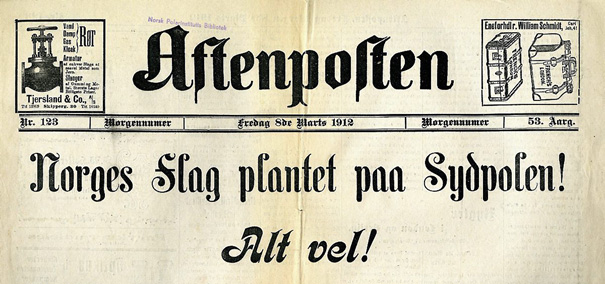Did you know that written Norwegian has two different words for the South Pole?The two words – Sørpolen and Sydpolen – both mean the same thing, but have slightly different connotations. Back at the time of Roald Amundsen, the southernmost point of the globe was usually called Sydpolen. Today it is usually referred to as Sørpolen. Languages are not static, but change over time.
Another factor at work here is that there are two different versions of written Norwegian: Nynorsk (New Norwegian) and Bokmål (Book language). In the past hundred years, Bokmål has develop in such a way that word forms of Danish origin have fallen out of use in favor of more “Norwegian-sounding” forms. “Syd” is now perceived as being more old-fashioned than “sør”. Likewise, the old Nynorsk form “sud” is no longer viable. According to current Norwegian spelling conventions, the pole is called Sørpolen in Nynorsk, while both Sørpolen and Sydpolen are acceptable in Bokmål. In the public sector it is practical to use Sørpolen, since this spelling is correct in both written forms of the language. Spoken language varies considerably throughout Norway – a country rich in dialects – and people can decide for themselves which word they want to use to describe the South Pole. There is great interest in polar history in Norway, and many still prefer to use the old version, Sydpolen, with its stronger connotations of historic heroism. And in Bokmål, that is just fine. Other European languages call the pole south, sud, süd, syd, sør, sör, söder, sur, zuid. In Old Norse the word was suðr, evidence as good as any that words migrate and transmute between languages. In Davvisámegiella, the Northern Sami Language, the South Pole is called Lullipola. The choice between “syd” and “sør” is determined by the choice of language form (Bokmål/Nynorsk) and context (historic versus modern). The officially approved Norwegian place names in Dronning Maud Land and Svalbard are all in Nynorsk. This means that there are no names containing “Syd-“ in these places. (The exception, Sydowbreen on Edgeøya in Svalbard, takes its name from a person, Theodor Emil von Sydow). Dronning Maud Land does not extend all the way south to the Pole, which thus lies outside the jurisdiction of the Norwegian Polar Institute as far as naming conventions are concerned. If this had not been the case, “Sørpolen” would have been the only approved spelling.  |
South Pole 1911–2011 is an informational outreach project run by the Norwegian Polar Institute
Contact person:


